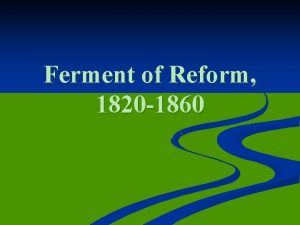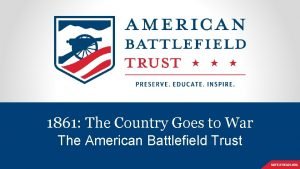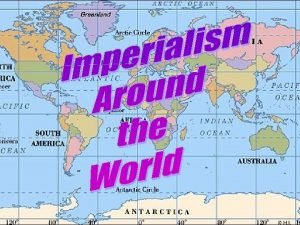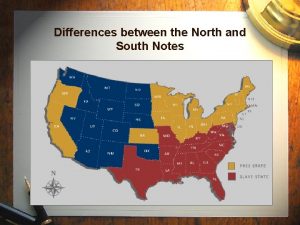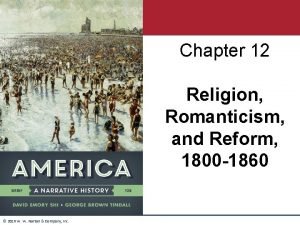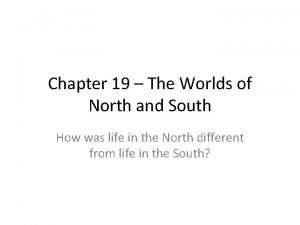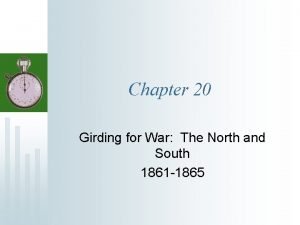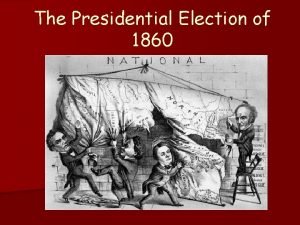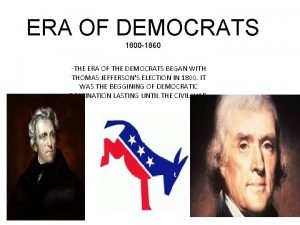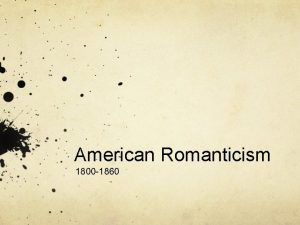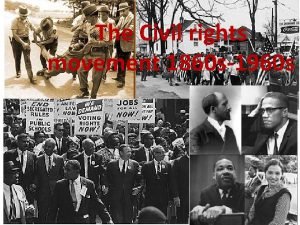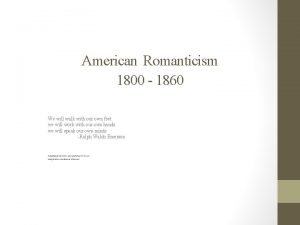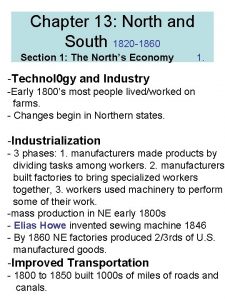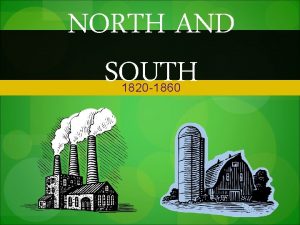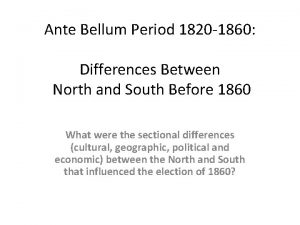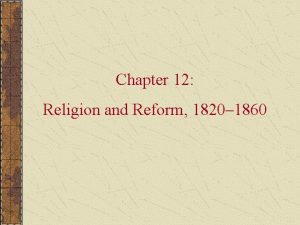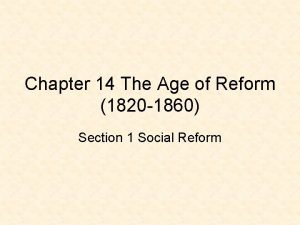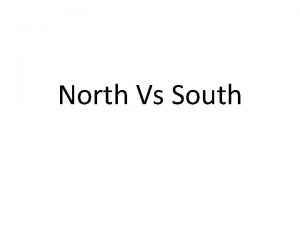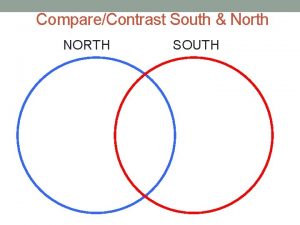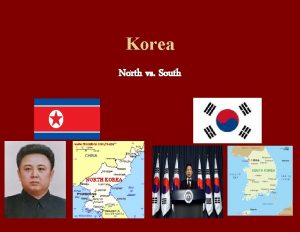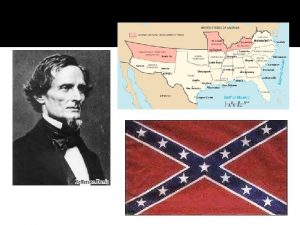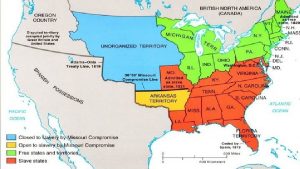Chapter 13 Notes North South 1820 1860 The


















- Slides: 18

Chapter 13 Notes North & South 1820 -1860

The North’s Economy Technology & Industry * Innovations – new ideas & methods – changed Americans way of life A. Industrialization 1) Industrialization in the north happened three phases: a) Specialized tasks b) Factory System c) Use of machinery 2) By 1860 – 2/3 rds of manufactured goods came from the northeast B. Improved Transportation 1) New roads & canals built – improved trade 2) 1840 s – Widened & deepened canals for steamboat use 3) Clipper ships invented a) could sail 300 miles a day b) Got their name by “clipping” time c) N. Y to Great Britain went from 28 days to 14 in

C. Locomotives 1) Railroads started in short stretches – connected mines with rivers 2) First locomotives were pulled by horses 3) First U. S. steam engine developed in 1830 D. A Railway Network 1) Between 1840 & 1860 – went from 3, 000 miles to 30, 000 miles of track 2) Development of east-west lines allowed grain, livestock, & dairy products to move from mid-west to east coast 3) Goods could be moved faster & cheaper 4) Also played a huge role in industrialization & settlement of mid-west

E. Faster Communication 1) Growth of industry & pace of travel – led to need for faster communication 2) Telegraph invented 3) 1844 - Samuel Morse invents Morse Code a) Series of dots & dashes b) Represents letters of the alphabet Agriculture A. Revolution in Agriculture 1) 3 inventions in 1830 s change farming a) John Deere – steel tipped plow b) Mechanical Reaper – harvest wheat c) Thresher – separate grain from stalk B. Mc. Cormick’s Reaper 1) Cyrus Mc. Cormick – invents reaper: a) Harvests grain much faster than by hand b) More wheat is planted & becomes main economic activity of the Midwest 2) New machines & railroads lead to “commercial agriculture” 3) North leans toward industry though – due to rocky soil of the northeast

Innovations – 1840 s

Innovations

The North’s People Northern Factories * Factory System develops – leads to need for reforms in working conditions A. Working Conditions 1) Working conditions worsened: a) 1840 - Avg. work day 11. 4 hrs. b) Dangerous conditions c) No AC during summer d) No heat in winter 2) No laws existed to protect workers B. Workers Attempt to Organize 1) 1830 s – trade unions organized a) Series of strikes organized 2) 1842 – Massachusetts court rules it is Legal to strike

C. African American Workers 1) By 1830 – very little slavery in the north 2) Prejudice & Discrimination still remained: a) African Am. Not allowed to vote b) Couldn’t attend public schools c) Segregated schools & hospitals d) Most African Am. were very poor D. Women Workers 1) Women were kept out of unions & paid less than men for the same work The Rise of Cities A. Increase in Urban Population 1) 1820 -1840 – small towns next to rivers develop into major cities a) St. Louis b) Pittsburgh c) Cincinnati d) Louisville 2) Growing centers of trade linked to farmers in the Midwest

B. Immigration 1) Big increase in immigration between 1840 & 1860 2) Irish – Largest Group a) Left Ireland due to “Potato Blight” (Famine) b) Settled in Northeast & took low paying factory jobs & RR jobs 3) Germans - 2 nd largest Group a) Came for opportunity – work b) Some came due to failed democratic revolution in Germany c) Many settle in Midwest & buy their own farms C. Impact (effect) of Immigration 1) Changed character of our country 2) Brought their culture with them, - Language, Religion, & Traditions

D. Immigrants Face Prejudice 1) Anti-immigrant feelings arise in the 1840 s 2) People opposed to immigration were called Nativists: a) Didn’t like immigrants taking their jobs b) or Working for lower wages c) Also accused them of bringing diseases * similar debate today with immigrants from Mexico (history repeats itself) E. The Know-Nothing Party 1) Answered questions with the statement “I know nothing” 2) Called for stricter citizenship policies: a) Extend wait from 5 to 21 years b) Ban foreign citizens from holding office

Southern Cotton Kingdom Rise of the Cotton Kingdom * Eli Whitney transformed cotton production with Cotton Gin A. Changes in the South 1) Population explodes into deep south (1850) 2) Economy booms with Cotton a) Problem is it relies on slavery b) Slaves no longer needed in north but growing in the south B. Cotton Rules the Deep South 1) Cotton is in high demand after the American Revolution 2) Very time consuming & labor intensive: a) Eli Whitney invents cotton gin – removes seed from the cotton fiber b) A worker could clean 50 times more per day 3) Led to increased production – which led to need for more slaves (Cause & Effect) 4) Deep south – Cotton 5) Upper South - Tobacco

Upper South Deep South Industry in the South * Industry in south develops slow – why? A. Barriers to Industry 1) Agriculture (especially Cotton) was very profitable 2) Lack of Money to invest in businesses 3) Lack of market to buy manufactured goods a) Many slaves that had no money 4) Many southerners simply did not want Industry – only wanted agriculture B. Southern Factories 1) Some argued lack of factories made the south too dependent on the North 2) Also felt it would help the economy of Upper South: C. Southern Transportation 1) Lack of Railroads & Roads slowed the development of southern cities 2) Also becomes a major problem during the Civil War

North & South Economies North South Innovations Cotton/Tobacco Industrialized & Progressing Agriculture & Staying the Same

The South’s People Farms & Plantations * Most southerners were actually owners of small farms with very few slaves A. Small Farmers & the Rural Poor 1) Yeoman – farmers without slaves a) make up largest group of whites in south b) Owned 50 -200 acres c) Grew their own crops (mostly in upper south) 2) Tenant Farmers – Rented land to farm 3) Majority of southern whites lived in simple homes like log cabins B. Plantations 1) Covered several thousand acres 2) Measured their wealth by number of slaves 3) Most slave owners had fewer than 10 slaves 4) Cotton prices varied from year to year – brought the need for cotton agents

C. Plantation Wives 1) Took charge of buildings & gardens 2) Were in charge of domestic slaves (house work) 3) Very difficult & lonely lifestyle D. Work on the Plantation 1) Needed many different workers a) Domestic Slaves b) Blacksmiths, carpenters, shoemakers, etc. c) Most were field hands – plant & harvest crops

Life Under Slavery A. Family Life 1) Slaves had very few comforts 2) Biggest fear was being separated from their family 3) Developed a large network of relatives & friends B. African American Culture 1) After 1808 – no “new” slaves could enter the U. S. 2) Native born slaves held onto their African Customs C. Slave Codes 1) Became more severe between 1840 -1860 2) Slave owners prohibited slaves from meeting in large groups: a) Feared a slave rebellion 3) Had to have written pass to leave property 4) Crime to teach slaves to read & write a) Feared educated slave might revolt

D. Resistance to Slavery 1) Very few rebellions – knew they would lose 2) Would work slow and break tools E. Escaping Slavery 1) Harriet Tubman & Frederick Douglass 2) Underground Railroad – Network of “safe houses” 3) Most escaped slaves – caught & returned to owner City Life & Education A. Life in Southern Cities 1) A few large cities – the top ten largest were all seaports or river ports B. Education 1) No statewide public education exists a) Parents that could afford it sent kids to private schools 2) Education started growing in mid 1800 s 3) South was behind in literacy a) Very few people per square mile b) Too far to send children to school

Vocab Quiz n Telegraph n Morse Code n Trade Unions n Strike n Prejudice n Discrimination
 Apush 1820 to 1860
Apush 1820 to 1860 American reform movements between 1820 and 1860
American reform movements between 1820 and 1860 South carolina 1860
South carolina 1860 South africa 1860
South africa 1860 Chapter 14 lesson 1 the industrial north
Chapter 14 lesson 1 the industrial north North and south notes
North and south notes Chapter 12 religion romanticism and reform
Chapter 12 religion romanticism and reform Lesson 19 the worlds of north and south
Lesson 19 the worlds of north and south Chapter 20 girding for war the north and the south
Chapter 20 girding for war the north and the south Border states in 1860
Border states in 1860 Evolution de l'aspirateur au cours du temps
Evolution de l'aspirateur au cours du temps Romantic period in american literature
Romantic period in american literature Definition
Definition Era of the democrats 1800-1860
Era of the democrats 1800-1860 Decreto 1860 de 1994
Decreto 1860 de 1994 American romanticism 1800 to 1860 worksheet answers
American romanticism 1800 to 1860 worksheet answers 1860
1860 American romanticism 1800 to 1860 worksheet answers
American romanticism 1800 to 1860 worksheet answers Rationalism vs romanticism
Rationalism vs romanticism

